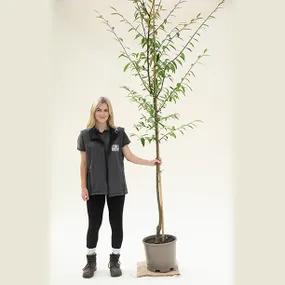Waterer's Cotoneaster, Garden Trees

The details
- White flowers in early summer.
- Red berries stay on the branches into early winter
- Semi-evergreen leaves turn yellow & red in autumn
- Wild looking, arching canopy.
- Easy to grow
- Good for butterflies & wildlife
- To 7 metres
Recommended extras
Description
Cotoneaster Standard Trees
Cotoneaster x watereri is a large, vigorous shrub that we have grown with a single stem into a small tree. It is very similar to Cotoneaster Cornubia: a bit more wild looking, with a more arching canopy, whereas Cornubia is that bit tidier and more neatly rounded.
Otherwise, it has the same clouds of white flowers, and loads of winter interest thanks to the semi-evergreen, long, narrow leaves that turn yellow and tan red in autumn and stay on the branch through the winter in most parts of Britain. To 6 metres.
Browse all of our Cotoneaster shrubs.
Features:
- White flowers in early summer.
- Red berries stay on the branches into early winter
- Semi-evergreen leaves turn yellow & red in autumn
- Easy to grow
- Good for butterflies & wildlife
- To 6 metres
Growing Cotoneaster x watereri
Suitable for any soil with decent drainage, it tolerates pollution and grows near the coast. Thrives on chalk. In sheltered locations, it will be in leaf almost all the year, and in exposed, cold places it will drop its leaves well after most other non-evergreen trees. It is likewise quite shade-tolerant, but it won't flower much in more than partial shade.
Prune straggly branches in winter.
Did You Know?
A hybrid of C. frigidus x C. salicifolius. Cotoneasters are popular roadside plants with town councils.
Standard trees are measured by their girth in centimetres 1 metre above ground level: their trunk's waist measurement. Unlike sapling trees and hedge plants, standards aren't measured by their height, which will vary quite a bit both between and within species.
So, a 6/8cm standard tree has a trunk with a circumference of 6-8cm and an 8/10 standard has a trunk 8-10cm around. This measurement makes no difference to the tree's final height.
On average, standard trees are 2-3.5 metres tall when they arrive, but we cannot tell you precisely how tall your trees will be before we deliver them.
Planting Instructions
Notes on planting Cotoneaster trees:
Cotoneasters will thrive in almost any soil. They like heavy clay as long as the site isn't waterlogged in winter (ideal sites on clay would be a raised bank or a slope). They will also tolerate poor, chalky or dry and sandy soils.
They are happy on the coast, so long as there is a decent ratio of organic matter to sand in the soil and they certainly aren't fazed by city pollution.
Prepare your site before planting:
It is good to dig over the site where you plant a tree several months in advance. Kill the weeds first: for tough weeds like nettles, brambles and ground elder, you will usually need a weed-killer to get rid of them. When you dig the soil over, remove stones and other rubbish and mix in well rotted compost or manure down to the depth of about 2 spades.
Watch our video on how to plant a tree for full instructions.
Remember to water establishing trees during dry weather for at least a year after planting.
Tree Planting accessories:
Prepare your site for planting by killing the weeds and grass with Neudorff WeedFree Plus.
You can buy a tree planting pack with a wooden stake & rubber tie to support the tree and a mulch mat with pegs to protect the soil around the base of your tree from weeds and drying out.
We suggest that you use mycorrhizal "friendly fungi" on the roots of all newly planted large trees: if your soil quality is poor, we strongly recommend it.
You can also improve your soil with bonemeal organic fertiliser and Growmore.

.webp)
.webp)
